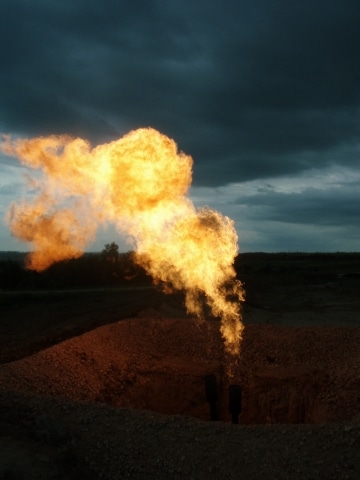This is a guest post by Lukas Ross from Friends of the Earth.
Big Oil has been subsidized to the hilt for over a hundred years. In the U.S. the spoils include everything from special interest tax breaks and accounting gimmicks to royalty-free leasing and government sponsored R&D. Add them all together and every year the costs run into the billions.
But one subsidy never seems to make the list, which is a shame because it is hardly small and incredibly polluting. What is it? Royalty-free flaring on public and tribal lands is a giant loophole that President Obama has the power to close before he leaves office.
The widespread burning away—or flaring—of natural gas is one of the uglier side-effects of the domestic energy boom. The average oil well can lead to the production of both oil and gas, but because oil is by far the more valuable commodity, for many drillers the “associated gas” is just an inconvenience. Simply burning it at the wellhead is often more economical than investing in the infrastructure to capture and sell it.
This is the financial logic that has made flaring so common that in places like North Dakota it is now visible from space. The results are lousy for air quality, since flaring produces a cocktail of over 250 different toxins, and lousy for the climate, since flaring pumps carbon dioxide directly into the atmosphere.
But an overlooked driver of this waste happens to be bad federal policy. On federal leases, where flaring nearly doubled between 2006 and 2013, the main regulator is the Department of the Interior’s Bureau of Land Management. Always too close to the industries it regulates, the BLM has the authority to waive royalty payments for flared gas on public and tribal lands—in effect giving it away for free. Last updated 35 years ago, existing regulations are really only supposed to allow flaring if a company can show that the only economically feasible way to reach oil is to burn gas.
Unfortunately, the approval process for royalty-free flaring isn’t a model of transparency. Practices are inconsistent between field offices, and most of the time it seems like the BLM is handing out permissions to flare like hall passes. Even less clear is which companies are benefitting the most. That’s why a new report from Friends of the Earth documents the biggest recipients of royalty waivers in the region that has become the national epicenter of the flaring boom: North Dakota’s Bakken Shale.
Between 2007 and 2013, data provided directly by the BLM shows that flaring on North Dakota public and tribal lands totaled 107.5 million mcfs. For reference, that’s an economic value of about $524 million and a carbon footprint equivalent to the annual emissions of 1.3 million cars. Also for reference, the BLM managed to collect $157. 38 from the tiny amount of flared gas that was charged royalties in 2014.
Although the BLM provided data for over 50 companies, the biggest burner by far is Harold Hamm’s Continental Resources, which was allowed to torch 55 million mcfs of gas—more than all the other operators combined for a grand total of $328 million in lost resources and a carbon pollution equivalent to over 360 million gallons of gasoline.
One of the more storied figures of the fracking craze, Hamm’s fortune is estimated by Forbes at $7.4 billion. He is also known as a political force on both the national stage and in his home state of Oklahoma. In 2012 he was an energy advisor to Mitt Romney’s presidential campaign and gave almost $1 million to Restore our Future, a Romney-aligned super-PAC. More recently, Hamm was in the news for his failed attempt to fire a member of the Oklahoma Geological Survey for research linking fracking waste wells to earthquakes.
Other companies that have benefited heavily from royalty free gas include XTO, a wholly-owned subsidiary of ExxonMobil, and EOG Resources, a former subsidiary of the ill-fated energy giant Enron. Even more worrying, one company—Marathon Oil—was responsible for nearly 1 million mcfs of vented gas. Arguably worse than flaring, venting sends methane, a greenhouse gas 87 times more potent than carbon dioxide over 20 years, into the atmosphere. This creates more warming in the short term at precisely the time when reducing emissions is most important.
The good news is that updating the rules on flaring and venting for public and tribal lands could be one of the final regulatory moves of the Obama administration. A proposed rule is expected any day, and it is well within the administration’s authority to permanently end royalty-free flaring, as well as the practice of venting altogether.
Acting soon to finalize new standards is important, and not just because time is running out on the Obama administration. The price of oil, half of what it was a year ago, could make the flaring boom much worse. Cash-strapped drillers are looking to both cut costs and maintain cash flow. This adds an extra incentive to treat gas as an unprofitable nuisance standing in the way of more profitable oil. Already North Dakota is backing away from state-level targets for reduced flaring, citing price concerns as one of the motives.
Ending this loophole immediately is an important step for air quality, for tax revenue, and most importantly, for our rapidly shrinking carbon budget. Preventing the worst of climate disruption means keeping at least 60 percent of already discovered fossil fuels in the ground. This means that allowing companies to flare doesn’t just subsidize Big Oil by handing them free resources. It also subsidizes the destruction of what little remains of our burnable carbon.
– by Lukas Ross, Friends of the Earth
Image credit: Joshua Doubek via Wikimedia Commons
Subscribe to our newsletter
Stay up to date with DeSmog news and alerts







